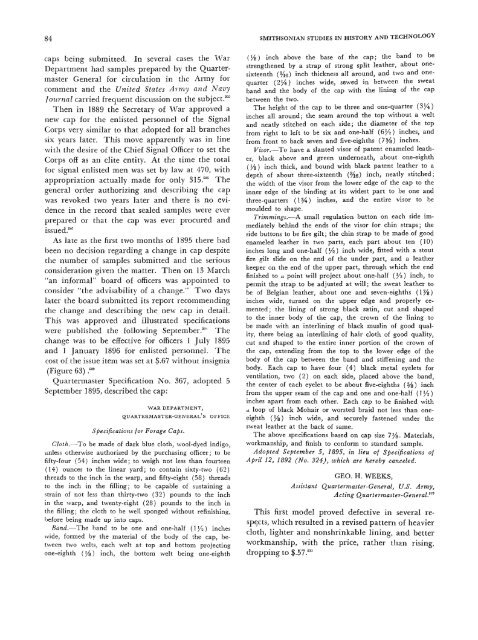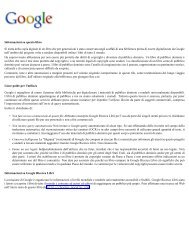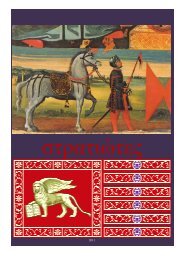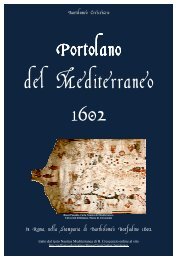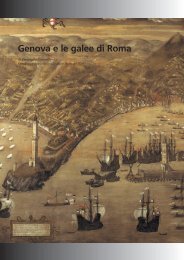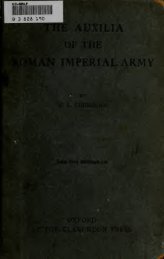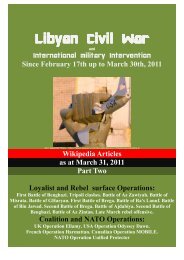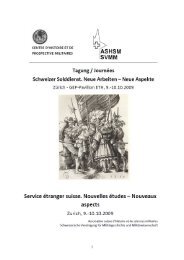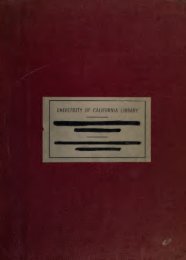United States Army Headgear 1855-1902 - Libreria Militare Ares
United States Army Headgear 1855-1902 - Libreria Militare Ares
United States Army Headgear 1855-1902 - Libreria Militare Ares
- No tags were found...
Create successful ePaper yourself
Turn your PDF publications into a flip-book with our unique Google optimized e-Paper software.
84 SMITHSONIAN STUDIES IN HISTORY AND TECHNOLOGYcaps being submitted.In several cases the WarDepartment had samples prepared by the QuartermasterGeneral for circulation in the <strong>Army</strong> forcomment and the <strong>United</strong> <strong>States</strong> <strong>Army</strong> and NavyJournal carried frequent discussion on the subject.''""Then in 1889 the Secretary of War approved anew cap for the enlisted personnel of the SignalCorps very similar to that adopted for all branchessix years later. This move apparently was in linewith the desire of the Chief Signal Officer to set theCorps off as an elite entity. At the time the totalfor signal enlisted men was set by law at 470, withappropriation actually made for only 315." Thegeneral order authorizing and describing the capwas revoked two years later and there is no evidencein the record that sealed samples were everprepared or that the cap was ever procured andissued.'As late as the first two months of 1895 there hadbeen no decision regarding a change in cap despitethe number of samples submitted and the seriousconsideration given the matter. Then on 13 March"an informal" board of officers was appointed toconsider "the advisability of a change." Two dayslater the board submitted its report recommendingthe change and describing the new cap in detail.This was approved and illustratedwere published the following September.'specificationsThechange was to be effective for officers 1 July 1895and 1 January 1896 for enlisted personnel.Thecost of the issue item was set at $.67 without insignia(Figure 63) .^^Quartermaster Specification No. 367, adopted 5September 1895, described the cap:WAR DEPARTMENT,QUARTERMASTER-GENERAL'S OFriCESpecifications for Forage Caps.Cloth.—To be made of dark blue cloth, wool-dyed indigo,unless otherwise authorized by the purchasing officer; to befifty-four (54) inches wide; to weigh not less than fourteen(14) ounces to the linear yard; to contain sixty-two (62)threads to the inch in the warp, and fifty-eight (58) threadsto the inch in the filling; to be capable of sustaining astrain of not less than thirty-two (32) pounds to the inchin the warp, and twenty-eight (28) pounds to the inch inthe filling; the cloth to be well sponged without refinishing,before being made up into caps.Band.—The band to be one and one-half (1 '/a ) incheswide, formed by the material of the body of the cap, betweentwo welts, each welt at top and bottom projectingone-eighth (Ys) inch, the bottom welt being one-eighth{Ys) inch above the base of the cap; the band to bestrengthened by a strap of strong split leather, about onesixteenth{Vie) inch thickness all around, and two and onequarter(254) inches wide, sewed in between the sweatband and the body of the cap with the lining of the capbetween the two.The height of the cap to be three and one-quarter (3J4)inches all around; the seam around the top without a weltand neatly stitched on each side; the diameter of the topfrom right to left to be six and one-half (6/2) inches, andfrom front to back seven and five-eighths {^Ys) inches.Visor.—To have a slanted visor of patent enameled leather,black above and green underneath, about one-eighth{Ys) inch thick, and bound with black patent leather to adepth of about three-sixteenth (%6) inch, neatly stitched;the width of the visor from the lower edge of the cap to theinner edge of the binding at its widest part to be one andthree-quarters (1^4) inches, and the entire visor to bemoulded to shape.Trimmings.—A small regulation button on each side immediatelybehind the ends of the visor for chin straps; theside buttons to be fire gilt; the chin strap to be made of goodenameled leather in two parts, each part about ten (10)inches long and one-half (/a) inch wide, fitted with a stoutfire gilt slide on the end of the under part, and a leatherkeeper on the end of the upper part, through which the endfinished to it point will project about one-half ('/>) inch, topermit the strap to be adjusted at will; the sweat leather tobe of Belgian leather, about one and seven-eighths {lYs)inches wide, turned on the upper edge and properly cemented;the lining of strong black satin, cut and shapedto the inner body of the cap, the crown of the lining tobe made with an interlining of black muslin of good quality,there being an interlining of hair cloth of good quality,cut and shaped to the entire inner portion of the crown ofthe cap, extending from the top to the lower edge of thebody of the cap between the band and stiffening and thebody. Each cap to have four (4) black metal eyelets forventilation, two (2) on each side, placed above the band,the center of each eyelet to be about five-eighths {Ys) inchfrom the upper seam of the cap and one and one-half (1 /a)inches apart from each other. Each cap to be finished withd loop of black Mohair or worsted braid not less than oneeighth(Ys) inch wide, and securely fastened under thesweat leather at the back of same.The above specifications based on cap size 7Ys- Materials,workmanship, and finish to conform to standard sample.Adopted September 5, 1895, in lieu of Specifications ofApril 12, 1892 (No. 324), which are hereby canceled.GEO. H. WEEKS,Assistant Quartermaster-General, U.S. <strong>Army</strong>,Acting Quartermaster-General.^'"This first model proved defective in several respects,which resulted in a revised pattern of heaviercloth, lighter and nonshrinkable lining, and betterworkmanship, with the price, rather than rising,dropping to 1.57.""


